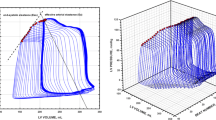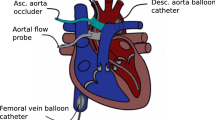Summary
We propose new indexes to evaluate the effects of ventricular inotropism and lusitropism on stroke volume. The end-systolic pressure-volume relationship (ESPVR) or its slope (Emax) has been employed to assess ventricular inotropism. The end-diastolic pressure-volume relationship (EDPVR) or compliance has been used to express ventricular diastolic properties or lusitropism. However, their net effect on stroke volume under a given set of preload and afterload pressures has not quantitatively been evaluated.Ejecting volume gain (Ge) was proposed to quantify the inotropic effect on stroke volume by the change in end-systolic volume between the two ESPVR curves obtained before and during an inotropic intervention at a specified ejecting pressure. Ge is a function of afterload pressure.Filling volume gain (Gf) was proposed to quantify the lusitropic effect on stroke volume by the change in end-diastolic volume between the two EDPVR curves before and during a lusitropic intervention at a specified filling pressure. Gf is a function of preload pressure. The net effect of these inotropic and lusitropic effects on stroke volume at these specified preload and afterload pressures can be expressed by the sum of Ge and Gf. We call this sumstroke volume gain (Gsv). Gsv is a function of preload and afterload pressures. Using representative examples, we demonstrate that these new indexes are conceptually useful to quantitatively understand changes in the pumping ability of the heart under simultaneous inotropic and lusitropic effects as a function of ejecting and filling pressures.
Similar content being viewed by others
References
Patterson SW, Starling EH (1914) On the mechanical factors which determine the output of ventricle. J Physiol (London) 48:357–379
Sagawa K (1978) The ventricular pressure-volume diagram revisited. Circ Res 43:677–687
Sunagawa K, Maughan WL, Burkhoff D, Sagawa K (1983) Left ventricular interaction with arterial load studied in isolated canine ventricle. Am J Physiol 245 (Heart Circ Physiol 14):H773-H780
Sarnoff SJ, Berglund E (1954) Ventricular function. Starling's law of the heart studied by means of simultaneous right and left ventricular curves in the dog. Circulation 9:706–718
Suga H, Sagawa K, Shoukas AA (1973) Load independence of the instantaneous pressure-volume ratio of the canine left ventricle and effects of epinephrine and heart rate on the ratio. Circ Res 32:314–322
Suga H, Sagawa K, Kostiuk DP (1976) Controls of ventricular contractility assessed by pressure-volume ratio, Emax. Cardiovasc Res 10:582–592
Little WC (1985) The left ventricular dp/dtmax-end-diastolic volume relation in closed-chest dogs. Circ Res 56:808–815
Glower DD, Spratt JA, Snow ND, Kabas JS, Davis JW, Olsen CO, Tyson GS, Sabiston DC Jr, Rankin JS (1985) Linearity of the Frank-Starling relationship in the intact heart: The concept of preload recruitable stroke work. Circulation 71:994–1009
Grossman W (1990) Diastolic dysfunction and congestive heart failure. Circulation 81 (Suppl III):III-1–III-7
Katz AM (1988) Influence of altered inotropy and lusitropy on ventricular pressure-volume loops. J Am Coll Cardiol 11:438–445
Rankin JS, Arentzen CE, Ring WS, Edwards CH II, McHale PA, Anderson RW (1980) The diastolic mechanical properties of the intact left ventricle. Fed Proc 39:141–147
Gaasch WH, Cole JS, Quinones MA, Alexander JK (1975) Dynamic determinants of left ventricular diastolic pressure-volume relations in man. Circulation 51:317–323
Gaasch WH, Levine HJ, Quinones MA, Alexander JK (1976) Left ventricular compliance: Mechanics and clinical implications. Am J Cardiol 38:645–653
Vogel WM, Apstein CS, Briggs LL, Gaasch WH, Ahn J (1982) Acute alterations in left ventricular diastolic chamber stiffness: Role of the “erectile” effect of coronary arterial pressure and flow in normal and damaged hearts. Circ Res 51:465–478
Glower DD, Schaper J, Kabas JS, Hoffmeister HM, Schaper W, Spratt JA, Davis JW, Rankin JS (1987) Relation between reversal of diastolic creep and recovery of systolic function after ischemic myocardial injury in conscious dogs. Circ Res 60:850–860
Momomura S, Bradley AB, Grossman W (1984) Left ventricular diastolic pressure-segment length relations and end-diastolic distensibility in dogs with coronary stenosis. Circ Res 55:203–214
Paulus WJ, Serizawa T, Grossman W (1982) Altered left ventricular diastolic properties during pacing-induced ischemia in dogs with coronary stenosis. Circ Res 50:218–227
Suga H, Hisano R, Goto Y, Yamada O, Igarashi Y (1983) Effect of positive inotropic agents on the relation between oxygen consumption and systolic pressure-volume area in canine left-ventricle. Circ Res 53:306–318
Wexler LF, Weinberg EO, Ingwall JS, Apstein CS (1986) Acute alternations in diastolic left ventricular chamber distensibility: Mechanistic differences between hypoxemia and ischemia in isolated perfused rabbit and rat hearts. Circ Res 59:515–528
Nozawa T, Yasumura Y, Futaki S, Tanaka N, Uenishi M, Suga H (1988) Efficiency of energy transfer from pressure-volume area to external mechanical work increase with contractile state and decreases with afterload in the left ventricle of the anesthetized closed-chest dog. Circulation 77: No. 5, 1116–1124
Suga H, Yasumura Y, Nozawa T, Futaki S, Tanaka N (1988) Pressure-volume relation around zero transmural pressure in excised cross-circulated dog left ventricle. Circ Res 63:361–372
Guyton AC (1963) Circulatory physiology: Cardiac output and its regulation. Saunders, Philadelphia, pp 193–208, pp 287–300
Sagawa K (1983) Baroreflex control of systemic arterial pressure and vascular bed. In: Shepherd JT, Abboud FM (eds) Handbook of physiology (section 2). The cardiovascular system III. American Physiological Society, Bethesda, Maryland, pp 453–496
Packer M (1990) Abnormalities of diastolic function as a potential cause of exercise intolerance in chronic heart failure. Circulation 81 (Suppl III): III-78–III-86
Sagawa K, Maughan L, Suga H, Sunagawa K (1988) Clinical use and limitation of ventricular ESPVR. In: Cardiac contraction and the pressure-volume relationship. Oxford University Press, New York, pp 299–339
Zile MR, Izzi G, Gaasch WH (1991) Left ventricular diastolic dysfunction limits use of maximum systolic elastance as an index of contractile function. Circulation 83:674–680
Author information
Authors and Affiliations
Rights and permissions
About this article
Cite this article
Takasago, T., Goto, Y., Futaki, S. et al. Ejecting volume, filling volume and stroke volume gains: New indexes of inotropism and lusitropism. Heart Vessels 7, 57–65 (1992). https://doi.org/10.1007/BF01744450
Received:
Revised:
Accepted:
Issue Date:
DOI: https://doi.org/10.1007/BF01744450




